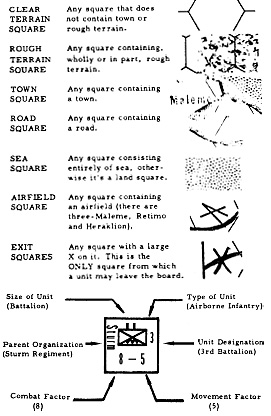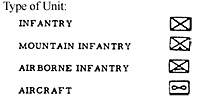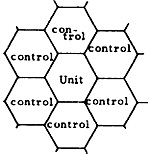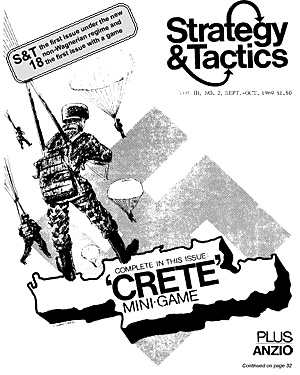Rules
 The Playing Boards
The Playing Boards
There are actually three different boards, each containing one of the three vital airfields found on Crete. The large board is to be referred to as Suda Bay, the two smaller ones Retimo and Heraklion after the towns found on them. A hexagon grid has been superimposed on the maps to determine movement. Hereafter these hexes will be called “squares”. Below is a description of the terrain features on the board:
Unit Counters
The unit counters represent the units which fought during the Crete campaign.
A description of them is found below:
Parent Organization: In German units this only refers to the regiment. In British units it refers to nationality. A = Austrian, NZ = New Zealand, G = Greek, none = British.
Combat Factor: A unit’s combat strength when defending
Movement Factor: The maximum number of squares a unit may move each turn.
Unit Designation: For German units refers to the number of the battalion within the parent regiment. For British units refers to the battalions own title (sometimes abbreviated).
Size of Unit: Either Battalion ( II ), or
Regiment (III). In this game none of the
units have a strength of greater than a
thousand armed men.
 Type of Unit:
Type of Unit:
How to Win
The game is one (sic) on points. You receive one point for each combat factor of enemy units you destroy. Also, at the end of the game you receive ten points if one of your units occupy Suda Bay. You also receive five points for each of the airfields that your units occupy. The side with the most points wins.
The Germans won the original campaign 105 to 64, but mainly because the British did not fight with the reckless fanaticism of the German paratroopers. The British evacuated instead and lost heavily in men left behind who were taken prisoner. If the Germans have more points by turn ten it’s quite probable that the British would have evacuated.
Length of Game
The game is ten turns long.
Setting up the Game
1 Remove the two maps from the magazine. Lay them out on a smooth, flat surface. Tape them down if necessary.
2 Cut out the counter sheet from the magazine. Using Magic Markers or colored pencils color the German counters red and the British counters blue. Then, using rubber cement (which is best, but other glues will do) glue the counter sheets to cardboard (or oaktag or anything else that looks sufficiently thick). It is best to put a thin coat of rubber cement on the counter sheets and the cardboard before putting them together. Finally, cut out the individual counters with scissors.
You may wish to do even better when coloring the counters You could use red for the British troops, different shades of brown for the Australians and New Zealanders and gold for the Greeks. The German airborne troops would be dark blue, the mountain troops green and Luftwaffe units light blue.
3 The game is now ready to play.
Preparing for Play
1 The German player writes down, in secret, which units will land in the first turn in each of the three airfield areas (maps). At least seven battalions must be landed. You may distribute the battalions among the three maps in any manner you wish, putting none in some of the areas if you wish. You are not writing down exactly where the battalions will be dropped, only the map onto which (sic)
2 The British player now distributes his units on the three mapboards in any manner he wishes.
3 You are now ready to start turn one of the game.
How to Play the Game
The game is played in complete turns, each consisting of the following steps:
Step 1 The Germans land any additional paratroops they wish (and have available). Also land and move any troops coming in by plane on a captured airfield. Move any of their other units they wish to move.
Step 2 German units may attack any British units they are adjacent to. No British movement is allowed at this time except for retreats after combat.
Step 3 British may move any of their units they wish to move.
Step 4 British may attack any German units they are adjacent to. No German movement is allowed at this time except for retreats after combat.
Step 5 British player marks off one turn on the time record and both players repeat steps 1-4 until the end of the game.
How to Move Units
1 In any turn you may move all your units on the board, except paratroopers which were landed that turn.
2 You may move each unit any number of squares not exceeding its normal movement rate.
3 You do not have to move every unit nor do you have to move any unit in your turn
4 You may move units in any direction or combination of directions you wish in the same turn.
5 Unlike chess or checkers you may move all units you choose to move before resolving attacks.
6 You may move units over top of friendly units but you are not allowed to move your units on top of your opponents units.
7 Movement rates are not transferable from one unit to another nor can they be accumulated from one turn to the next.
8 The die is used only to resolve battles, it has nothing to do with movement.
9 Units may use “partial” squares on the edges of the board. But units may not leave the board except by way of the exit squares.
 Zones of Control
Zones of Control
Each unit “controls” the movement of enemy units in the squares adjacent to it. When an enemy unit enters one of the six squares adjacent to one of your units it must stop and move no further that turn.
On subsequent turns enemy units in your units’ zones of control may not move directly from one enemy controlled square to another controlled by the same enemy unit. You MAY move from one enemy controlled square to another belonging to another enemy unit. The diagram below shows which squares each unit “controls” (their Zone of Control):
How to Have Combat
After you have finished moving your units, and before the other player moves his, you may attack any enemy units you are adjacent to.
1 You may attack as many enemy units as you can reach in the same turn.
2 You resolve combat one battle at a time after moving all the units you choose to move in that turn.
3 The player moving his units is always the attacker; his opponent is the defender.
4 To determine battle odds the attacker’s combat factor is first stated and the defender’s combat factor is stated second. For example: If the 3rd battalion of the German Sturm Regiment (8) attacks the 2/2 Australian infantry battalion (3) battle odds are 8 to 3 which reduces to 2-1. To resolve combat the attacker rolls the die and matches up the die roll with the 2-1 column in the Combat Results Table.
5 The attacker has the choice of resolving battles in any order he wishes.
6 The attacker does not have to attack every enemy unit he has moved units adjacent to.
7 The combat factor of a unit when attacking is always the same regardless of the terrain it is attacking from.
8 The defending player is not allowed to move any units while his opponent is attacking.
9 The combat factor of a unit is doubled when defending in rough terrain or a town.
10 For both attacking and defending all the units on a square must add together their combat factors and use them as if they were one. Units on the same square may not be attacked individually nor may they, if attacking, attack more than one square.
11 When retreating, a unit may not retreat into an enemy zone of control. You MAY retreat into a square occupied by a friendly unit which also happens to be a square covered by an enemy zone of control.
12 When retreating, the defending unit must move towards the nearest road and away from the attacking units, unless otherwise blocked by enemy zones of control. The defender moves retreating units.
13 If a unit rolls a CA (Counter Attack) and can neither counter attack nor retreat then it is destroyed.
14 A unit forced to retreat off the board (except at the “exit” road squares) is destroyed. You may not move off the board except at the “exit” road squares. You may not enter sea squares.
More Than One Unit Per Square
1 You may have no more than three units on a square, including Luftwaffe aircraft units (which are removed after each attack).
2 Stacked units may stay together indefinitly or they may combine on one turn and split up on the very next.
3 Stacked units may pass over squares containing other friendly units.
4 The movement rate of stacked units is that of the slowest unit in that stack. Of course, the fastest unit may continue on its way after splitting away from the slow moving units.
Effect of Terrain Features on Combat
1 When moving on roads , through any-type of terrain, units may triple their movement factor.
2 When moving through rough terrain you must use up an extra movement factor for each square of rough terrain you move into.
3 Units may combine clear terrain, rough terrain and road movement in the same turn as long as they do not exceed their basic movement rate. For example: The German 2nd battalion, 3rd Fallschirmjagerregiment (Parachute Regiment), which has a movement factor of 5. It starts its turn on a rough terrain square and moves into a clear terrain square (giving up one factor) and then onto a road square and then two more road squares (giving up another factor) and then into a rough terrain square (giving up two factors). It would like to move into another rough terrain square, but only has 1 movement factor left thus it must either remain where it is or move back into the road square it just left.
4 The square a unit is moving INTO is the square it in considered to be moving ON.
Supply
There are no supply restrictions on units.
How to Move From Board to Board
There are three different boards in the game. You may LEAVE each board only on the road. Once you have left a board on the road you may enter the adjacent board either on the road or, if that is blocked by an enemy unit, on the nearest unblocked (by enemy zones of control) nonroad square. The procedure for moving from board to board is as follows:
Step 1 You move on the road which (as indicated on the map) goes to the adjacent board until you are at the road square marked with an X. You may move no farther that turn.
Step 2 On the next turn you move to the board indicated. If the X road square on the next square is occupied by an enemy unit or enemy zone of control you must enter on the nearest unblocked non-road square.
When,you enter the board you are traveling to you do so with your full movement factor unused.
How to Drop Parachute Units
On the first turn the Germans may drop all their airborne units (there are 13) but no fewer than seven.
1 Airborne units may not be dropped directly on enemy units.
2 Airborne units may be dropped in stacks of as many as three units.
3 When dropped, each airborne unit must have the die rolled for it to see if it will “scatter. “ On clear terrain a die roll of 1 or 2 means a scatter. On rough terrain or in towns a die roll of 1, 2, 3 or 4 means a scatter.
4 If you roll a “scatter” for a unit you must roll the die again. A 1 means that the unit is landed in the hexagon directly north. (see the compass on the main map) of the original “drop zone”.
If a 2 is rolled you place the unit in the square to the right of the “north” square.
A 3 places the unit to the right of the “die roll 2” landing square. In other words, if you roll a “scatter” you will land on one of the squares surrounding the original square you intended to land on. The six possibilities on the die represent one of the six possible “scatter” squares.
5 If a parachute unit, through a “scatter” lands on an enemy unit it must immediately attack that unit using ONLY the all out attack table.
6 In the turn they land parachute units may not move from the squares they landed in nor may they attack. On the next turn they may be used like any other unit.
Use of Luftwaffe Units
The German Luftwaffe aircraft units are only used to support German attacks. They have no movement factor, only a combat factor. Each turn, just before the Germans attack, they may place these aircraft on top of any of their attacking units. The aircraft units cannot attack by themselves, they must always be in the same square as a German ground unit when attacking. You may not stack more than three ground units and aircraft units together on the same square. When an EX (exchange) occurs in combat you must remove the ground unit.
AIRCRAFT UNITS CANNOT BE DESTROYED.
They may be reused every turn except in the case of German parachute units which accidentally drop on British units. In this event you may not use aircraft units to support theme particular attacks.
Landing Mountain Troops on Airfields
The only “reinforcements” used in the game are the twelve battalions of German mountain troops which may land on any airfield as soon as British units have been cleared from one of them. Any time there are no British units on an airfield the Germans may land up to three battalions of mountain troops (or less, if there are already German units on the airfield) during the movement portion of their turn. These units may move on the same turn they land.
If a British zone of control covers the airfield they may still move upon landing as long as they move out of the zone of control into a non controlled square.
 (Following the rules were several pages
of designer’s notes. The game
description for Crete also included a
Time Record chart, which has been left
out of this summary simply because it
was trivial. The original chart was a
10x10 grid with the 10 game turns in
ascending order down the y-axis, and 10
game numbers along the x-axis. The
instructions were to check off one turn
after both players had moved.
(Following the rules were several pages
of designer’s notes. The game
description for Crete also included a
Time Record chart, which has been left
out of this summary simply because it
was trivial. The original chart was a
10x10 grid with the 10 game turns in
ascending order down the y-axis, and 10
game numbers along the x-axis. The
instructions were to check off one turn
after both players had moved.
The S&T games became more sophisticated over time, yet this first primitive effort contained the rudiments of many SPI characteristics ... numbered rules, typical CRT, cookie-cutter units, detailed historical and designer’s notes, some interesting chrome, and some last-minute additions that didn’t get properly integrated into the rules (such as the two types of combat with their own CRTs).
But at this stage in the proceedings, SPI cum Poultron Press was uncertain enough about reader feedback to editorialize with: “If you show a great deal of enthusiasm for this sort of thing we’ll make it a regular feature, say every other issue or something like that.” They probably had no idea that enthusiasm would result in a game in every issue. -ed)
Crete (S&T 18)
Back to Simulacrum Vol. 5 No. 1 Table of Contents
Back to Simulacrum List of Issues
Back to MagWeb Master Magazine List
© Copyright 2003 by Steambubble Graphics
This article appears in MagWeb (Magazine Web) on the Internet World Wide Web. Other articles from military history and related magazines are available at http://www.magweb.com